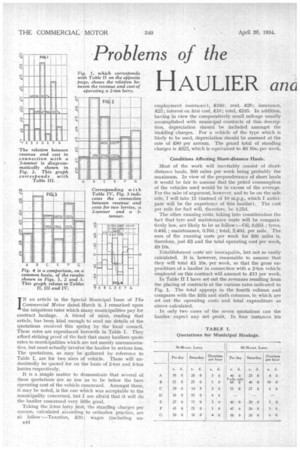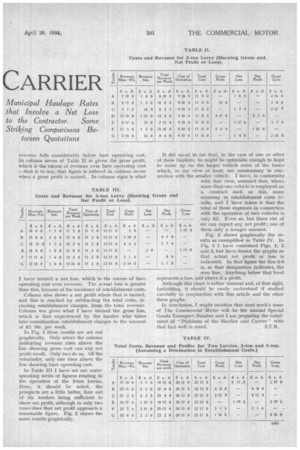Problems of the
Page 58

Page 59

If you've noticed an error in this article please click here to report it so we can fix it.
HAULIER an6
CARRIER
Municipal Haulage Rates that Involve a Net Loss to the Contractor. Some Striking Comparisons Be tween Quotations
IN an article in the Special Municipal Issue of The Commercial Motor dated March 9, I remarked upon the iniquitous rates which many municipalities pay for contract haulage. A friend of mine, reading that article, has been kind enough to send me details of the quotations received this spriing by the local council. These rates are reproduced herewith in Table I. They afford striking prool of the tacit that many hauliers quote rates to municipalities which are not merely uriremunerafive, but must actually involve the haulier in serious loss. The quotations, as may be gathered by reference to Table I, are for two sizes of vehicle. These will 'undoubtedly be quoted for on the basis of 2-ton and 3-ton
lorries respectively. 1 " It is a simple matter to d rnonstrate that several of these quotations are so low as to be below the bare operating cost of the vehicle concerned. Amongst these, it may be noted, is the one which was acceptable to the municipality concerned, but •X am afraid that it will do the haulier concerned very little good. • Taking the 2-ton lorry hrst the standing charges per annum, calculated according to orthodox practice, are as follow :—Taxation, 230 ' wages (including un h44 employment insurance), 2160 ; rent, 220; insurance, £25; interest on first cost, £10; total, 2245. In addition, having in view the comparatively small mileage usually accomplished with ninnicipal contracts of this description, depreciation should be included amongst the standing charges. For a vehicle of the type which is likely to be used, depreciation should he assessed at the rate of 280 per annum. The grand total of standing charges is 2325, which is equivalent to 20 1.0s.. per week.
Conditions Affecting Short-distance Hauls.
Most of the work will inevitably consist of shortdistance hauls, 300 miles per week being probably the maximum. In view of the preponderance of short hauls it would be fair to assume that the petrol consumption of the vehicles used would be in excess of the average. For the sake of argument, however, and to be on the safe side, I will take 12 (instead of 10 m.p.g., which I anticipate will be the experience of this haulier). The cost per mile for fuel will, therefore, be 1.25c1.
The other running costs, taking into consideration the fact that tyre and maintenance costs will be compara tively low, are likely to be as follow 0.05d.; tyres, 0.40d.; maintenance, 0,70d.; total, 2.40d. per mile. The sum of the running costs per week for 300 miles is, therefore, just £3 and the total operating cost per week, 29 10s.
'Establishment costsare inescapable, but not so easily calculated. It is, however, reasonable to assume that they will total £1 10s. per week, so that the gross expenditure of a haulier in connection with a 2-ton vehicle employed on this contract will amount to 411 per week.
In Table II I have set out the revenues resulting from the placing of contracts at the various rates indicated in Fig. 1. The total appeals in the fourth column and compares with the fifth and sixth columns, in which are set out the operating costs and. total expenditure as above calculated.
In only two cases of the seven quotations can the haulier expect any net profit. In four instances his revenue falls considerably below bare operating cost. In column seven of Table II is given the gross profit, Which is the excess of revenue over bare operating cost —that is to say, that figure is entered in column seven when a gross profit is earned. In column eight is what
I have termed a net loss, which is -the excess -of bare operating cost over revenue. The actual loss is greater than this, because of the incidence of establishment costs.
Column nine shows a net profit where that is earned, and this is reached by subtracting the total costs, including establishment charges, from the total revenue. Column ten gives what I have termed the gross loss, which is that experienced by the haulier who takes into, consideration establishment charges to the amount of LI I0s. per week
In Fig. 1 these results are set out graphically. Only where the column indicating revenue rises above the line showing gross cost can any net profit result. Only two do so. Of the remainder, only one rises above the line showing bare operating cost.
In Table III I have set out corresponding series of figures relating to the operation of the 3-ton lorries. Here, it should be noted, the prospects are a little better, four out of six tenders being sufficient to show nei profit, although in only two cases does that net profit approach a reasonable figure. Fig. 2 shows the same results graphically.
It did occur to me that, in the case of one or other Of these haulier, he might be optimistic enough to hope to make up on the larger vehicle some of the losses which, in my view at least, are unnecessary in connection with the smaller vehicle. I have, in conformity with that view, assumed that, where more than one vehicle is employed on a contract such as this, some economy in establishment costs results, and I have taken it that the
total of these expenses in connection with the operation of two vehicles is anly £2. Even so, but three ciut of six can expect any net profit ; one of them only a meagre amount.
Fig. 3 shows graphically the results as exemplified in Table IV. In Fig. 4 1, have combined Figs. I, 2 and 3, but have drawn the graphs so that actual net profit or loss is indicated. In that figure the line 0-0 is, as that designation indicates, the
zero line. Anything below that level tepresents a loss, and above it a profit.
Although this chart is rather unusual and, at first sight, forbidding, it should be easily understood if studied carefullyin conjunction with this article and the other three graphs.
In conclusion, I might mention that next week's issue of The Commercial Motor will be the annual Special Goods Transport Number and I am . preparing the instalment of "Problems of the Haulier and Carrier" with that fact well in mind.




























































































